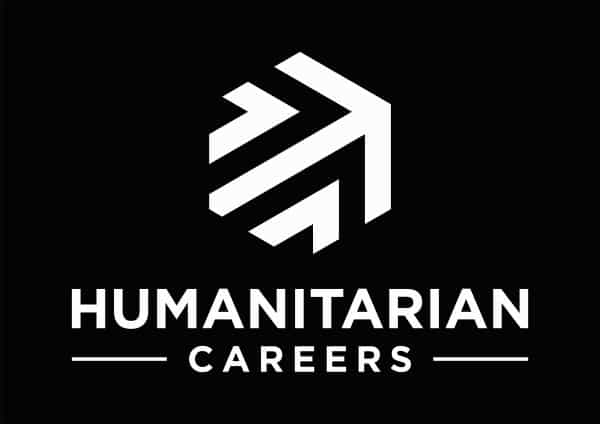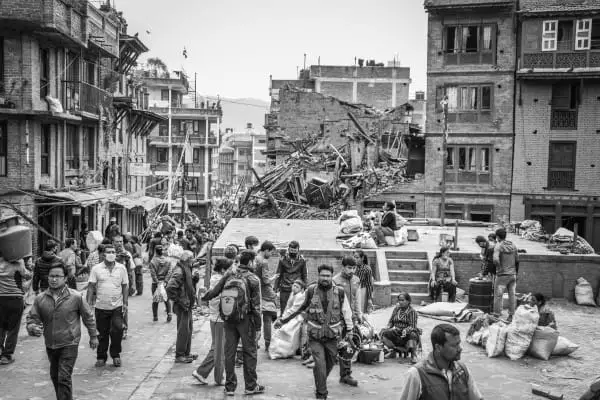This page contains affiliate links. This means if you a follow a link and make a purchase, at no additional cost to you, Humanitarian Careers will receive a commission. Thank you for supporting the site.
Humanitarian crises affect millions of people each year. Conflicts, natural disasters, disease pandemics, extreme weather and human displacements all require urgent responses to save lives and alleviate suffering. But what kind of assistance do humanitarian organization’s provide? Let’s take a look at the main types of humanitarian aid.
Food
A first type of humanitarian aid is food. When people are impacted by conflicts, crises or disasters, often their access to food is limited. Humanitarian aid agencies distribute food to ensure affected people have enough to feed themselves and their families.
Food is vital for human survival and that’s a why it’s one of the most important types of humanitarian aid. Without food aid, people would become mal-nutritious – which causes long-term health issues. Deaths would also increase if people go for extended periods without food aid.
Almost all types of crises require food aid to be distributed. However, in some crises, such as famines, droughts and extreme weather, food aid can be the main type of humanitarian assistance delivered. This is because these events destroy communities’ access to food and widespread starvation can set-in if food aid isn’t urgently distributed.
There are many humanitarian organizations that have food aid as one of the main types of assistance they deliver. These include Action Contre la Faim, the World Food Programme and Oxfam.
Non-Food Items
As well as food, non-food items (NFI) are a major type of humanitarian aid. In the aid sector, the term NFI covers a wide range of items distributed to people affected by crises.
Common types of NFI’s that are distributed by humanitarian NGOs include clothes, hygiene kits and cooking equipment. The exact types of NFI’s given to crisis affected people depends on their exact needs and the context. Aid agencies will conduct a needs assessment in order to understand the exact requirement affected communities have.
Almost all humanitarian crises require the distribution of NFIs. When communities are affected by disasters or conflicts, people often lose many of their possessions. Critical items must be given by humanitarian organizations in order to protect people and prevent disease and even death.
Almost all humanitarian agencies distribute some types of NFIs. A few of main ones include that focus heavily on NFIs are Save the Children, World Vision and UNHCR.
Shelter
Another type of humanitarian aid is shelter. When communities are hit by disasters or conflicts, people lose their homes. Humanitarian agencies distribute materials to rebuild houses, as well as provide materials so that people can make their damaged homes habitable in an emergency. Aid agencies can also construct camps for displaced people that provide them with emergency shelter.
Shelter is a key type of humanitarian assistance. It is important for people’s protection and health – allowing them a place to be away from often harsh weather conditions. Shelter is also important for families with children and for a sense of community. It is one of the most critical types of humanitarian aid.
Almost no matter the kind of humanitarian crises, there will be an urgent need for affected people to be provided with shelter. Conflicts, earthquakes and extreme weather are all examples of crises that destroy homes and require shelter provision to be provided. This is why it is one of the main types of humanitarian assistance.
ShelterBox, Save the Children and UNHCR are some of the most well-known aid agencies that work on shelter provision.
Healthcare
Healthcare is another type of humanitarian aid. When communities are impacted by humanitarian crises, many people lose access to quality healthcare. This is because health infrastructure, such as hospitals and clinics, are often damaged and made inoperable, and because health workers such as doctors and nurses are displaced. Supplies of drugs and medical equipment are also often disrupted by humanitarian crises.
People affected by all kinds of humanitarian crises require medical assistance. Crises, conflicts and disasters cause widespread injury and death. Humanitarian organisations respond by running medical clinics, or by supporting local health facilities through trainings, drug donations and rehabilitations.
Healthcare is one of the mostly commonly thought of types of humanitarian aid.
There are many humanitarian organizations that focus on providing healthcare to crises affected people. These include Médecins Sans Frontieres, Médecins du Monde, the International Medical Corps and Relief International.
Humanitarian Aid Online Courses
If you want to learn more about humanitarian aid, including the different types, we highly recommend the online course When Disaster Meets Conflict by the Erasmus University Rotterdam. We think it’s one of the best overviews of the humanitarian sector. Follow the link to the course’s page for more information.
The International Humanitarian Law Theory and Practice online course offered by Leiden University in the Netherlands provides a fantastic theoretical overview of humanitarianism. We think it’s one of the top online courses for those who want to understand the basics of international humanitarian law. Click the link to visit the course’s page for more information.
If you are looking to work in humanitarian aid, we highly recommend the online course International Humanitarian and Development Careers. We think it also provides one a great overview of the humanitarian sector and gives valuable insights for those searching for jobs in humanitarian aid. Follow the link to the course’s page.
Mental Health and Psycho-Social Support
Mental health and psycho-social support (MHPSS) is another type of humanitarian aid. Humanitarian crises can be hugely traumatic events. Affected people often need extensive mental health support as a result.
Humanitarian NGOs runs a range of activities that aim to improve people’s mental health and assist them to return to their lives. They also run community awareness sessions to promote mental health and outreach so that the wider community is aware of what mental health support is on offer.
MHPSS as a type of humanitarian aid differs greatly depending on the context and the society in which the programme is ran. Mental health support as part of a humanitarian response must be tailored to the affected community’s needs as well incorporating their current cultural views of mental health.
There are several famous humanitarian organisations that focus on MHPSS as a type of humanitarian aid. These include Médecins du Monde, Action Contre le Faim and Premiere Urgence International.
Water and Sanitation
Water and sanitation – known as WASH in the aid sector, is another major type of humanitarian assistance. Disasters and conflicts often have a significant impact on people’s ability to access clean water and good sanitation. Humanitarian organisations work to provide these key services in order to reduce the spread of disease.
When people are displaced by humanitarian crises, they also often lack access to water and sanitation. This is another reason why many humanitarian NGOs focus on this type of aid.
A lack of clean water and adequate sanitation can massively exacerbate the impacts of humanitarian crises. Diseases spread by poor sanitation and dirty water – such as cholera, can cause huge numbers of death and result in additional humanitarian emergencies.
Almost all kinds of humanitarian crises require some type of humanitarian WASH response.
Major humanitarian organizations that focus on water and sanitation as a type of humanitarian aid include WaterAid, Oxfam and CARE International.
Livelihoods Programming
Livelihoods are people’s ability to make a living, such as their business or job. When communities are hit by crises huge numbers of people lose their ability to make a living. Humanitarian organizations run livelihood programmes to help people rebuild their business and to provide jobs to affected people.
Livelihood’s programming is a key type of humanitarian aid. Without livelihoods projects, many people hit by disasters and crises would struggle to rebuild their businesses and return to their jobs. Humanitarian livelihoods work helps to boost the local economy and prevent a pro-longed crises.
All humanitarian emergencies have negative effects on people’s livelihoods. Conflicts and displacement destroy businesses and force people to move away from where they work. Natural disasters damage the infrastructure needed to support businesses and jobs. Famines and droughts divert people away from their work in search of food. These are all reasons livelihoods work by humanitarian NGOs is a crucial type of aid.
Some of the leading humanitarian organizations that run livelihoods projects include Oxfam, Save the Children and the IFRC.
Cash Transfers
Another type of humanitarian aid is cash payments. This is when humanitarian organisations directly transfer funds to people affected by crises.
Cash transfers as a type of humanitarian aid has become more prominent in recent years. The advantages of providing cash to beneficiaries is that it gives them the freedom to purchase the items they need. It not only gives them the dignity of choosing but also avoids aid being wasted as each person can buy only the specific things they require.
Another advantage of cash transfers as a type of humanitarian aid is that it stimulates the local economy. It also avoids issues of aid agencies shipping in items that could actually be bought locally, removing trade from local businesses and distorting the local market.
In the coming years it is likely cash will become a more prominent type of humanitarian assistance.
There are a number of humanitarian organizations that specialize in cash transfers as a type of humanitarian aid. Some of these are Save the Children, Oxfam and UNHCR.
Education
Humanitarian crises impact millions of children each year. Often, their schooling is disrupted. Providing emergency education is a key type of humanitarian aid.
All children have a right to an education, this includes those affected by disasters or forcibly displaced due to conflict. However, disasters and conflicts often damage school infrastructure and displace key staff like teachers. Humanitarian aid agencies step-in and run emergency education programmes that provide schooling to young people. They also help local authorities re-establish the education system and work to get children back into regular schooling.
Children are hugely impacted by humanitarian crises. In recent decades, education in emergencies has been seen as crucial type of humanitarian aid.
There are a number of specialist humanitarian organization’s that focus on education as a type of aid. These include Save the Children and CARE International.
Child Nutrition Programming
Humanitarian child nutrition programming aims to prevent malnutrition in young children. It is a key type of humanitarian aid in areas of famine.
Famines are a major cause of humanitarian crises. When droughts or extreme weather destroy crops, huge numbers of people can go without food. Conflicts can also cause famine as people lose access to food or food is controlled by armed groups.
Humanitarian child nutrition programming aims to ensure children are not adversely affected by a lack of food. Malnutrition in children can cause long-term impacts.
As a type of humanitarian aid, childhood nutrition projects can also focus on promoting breast feeding and developing awareness in communities of good child feeding practices.
Several humanitarian NGOs focus on child nutrition programming as a type of aid. These include Save the Children and UNICEF.
Protection
When humanitarian crises hit, vulnerable members of the community require protection. Humanitarian agencies run projects to protect at risk people and it is a crucial type of humanitarian assistance.
Many groups within society are more at risk of harm, exploitation or abuse. Women, children, and sexual and ethnic minorities can be especially vulnerable. In a humanitarian crises, the societal networks that often assist more vulnerable people can be broken. This is reason why protection has become a major type of humanitarian aid.
Humanitarian protection as type of aid can be in many forms. Often aid agencies run case management programmes and refer people in need to local organizations that can assist. They can also run shelters, create safe spaces and run awareness sessions highlighting risks for certain groups within the community.
Some of the leading humanitarian organisations that run protection programmes include Save the Children, War Child and Terre des Hommes.
Tele-Communications
A final type of humanitarian aid is tele-communications. When crises hit, the infrastructure needed to connect people, such phone lines and the internet, are often damaged or disrupted. During a crises people urgently need to contact others and so tele-communications is a vital type of humanitarian assistance.
Emergency tele-communications has become a more important type of humanitarian aid in recent years. This is because more people are connected by phones and the internet. People impacted by humanitarian crises need to contact people in non-affected areas as well as locate friends and family also in the area of the disaster.
When people are displaced, they directly need to stay in contact to plan their movements and find safe routes. This is another reason why tele-communication is a vital type of humanitarian assistance.
The United Nations cluster system recognizes emergency communications as a type of humanitarian aid. Other humanitarian organizations that works on humanitarian tele-communications are Engineers Without Borders and Internews.
If you want to learn more about humanitarian aid, explore our list of the top humanitarian aid online courses here.





